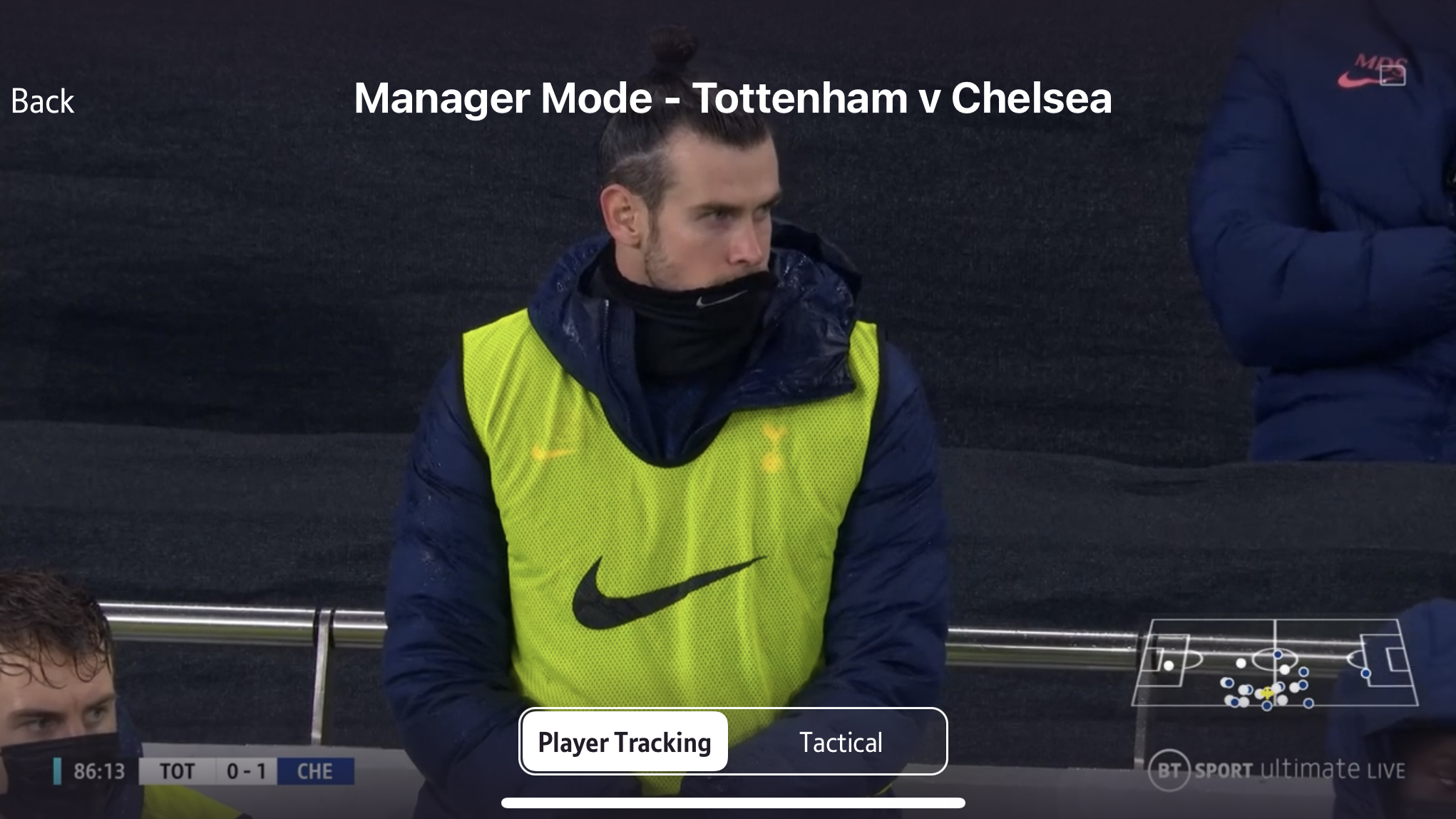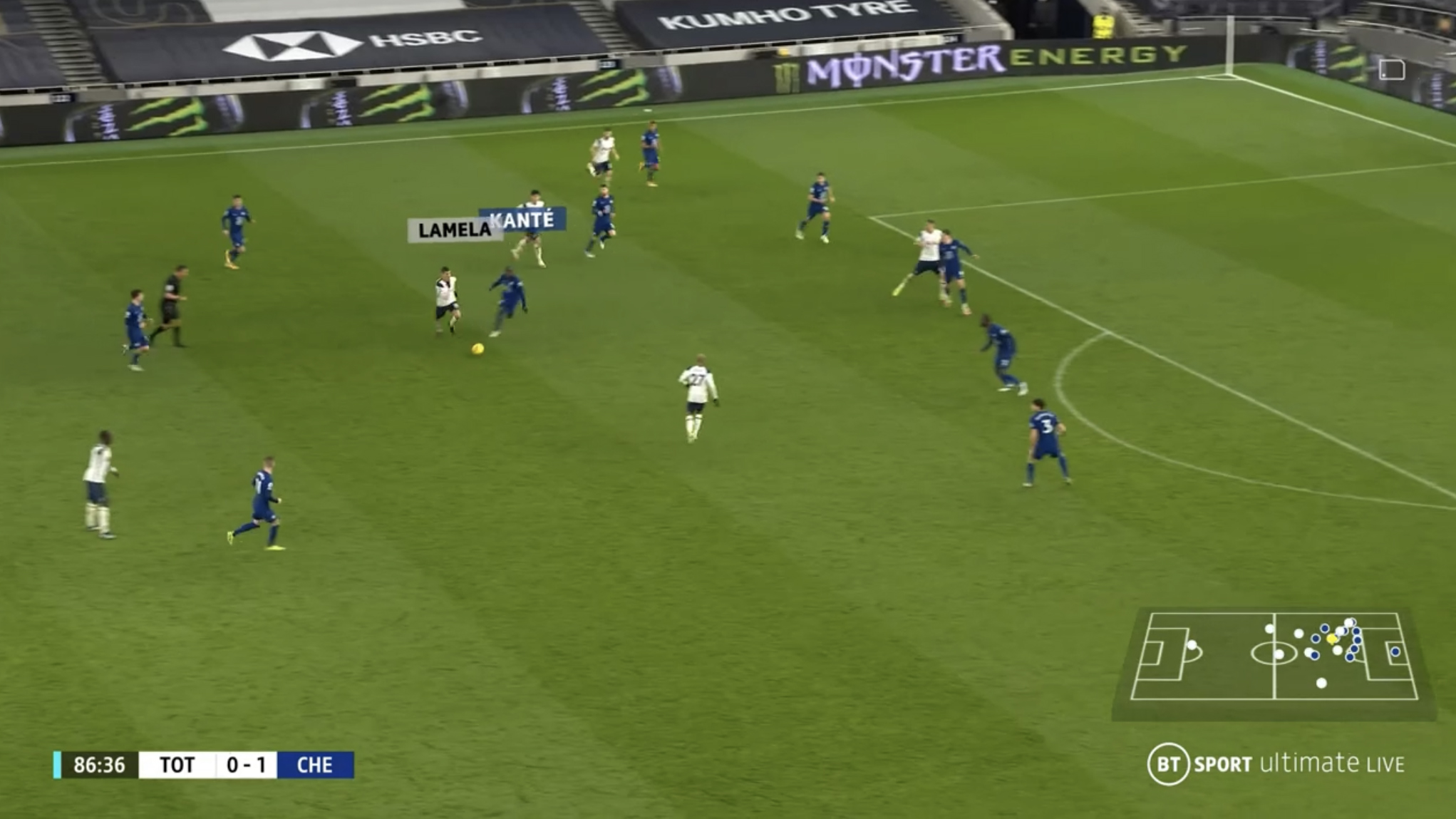BT Sport's Manager Mode: the new TV tech that turns football fans into armchair analysts
Become a mini Mourinho without leaving your sofa

EA Sports has spent the past 30 years trying to replicate the codes and conventions of televised football in its annual FIFA series – but not many features from the games have made the jump the other way.
Fire up BT Sport’s app on your phone, tablet, smart TV or games console, though, and you now have the option to overlay a FIFA-style radar pitch map in the bottom corner of the screen, which shows you where all 22 players and the ball are at all times.
It’s part of the broadcaster’s new Matchday Experience, which also includes a split-screen communal viewing mode called Watch Together, an enhanced 360-degree camera option, and AR stadium tours. But this so-called Manager Mode is different to what’s come before in that it’s designed purely to give fans a better understanding of what’s going on from a tactical point of view – no extra pixels, third dimensions or superficial gimmickry.
“We wanted to do something that used AR technology to give the viewer additional information without having to use a second screen,” BT Sport COO Jamie Hindhaugh tells TechRadar.
Pro’s eye view

Sky Sports tried to do something similar back in 2015 when it introduced Tactical Cam to its Monday Night Football games. Viewers could choose to watch from a single camera positioned high up in the stands and level with the halfway line, like a professional analyst would do.
MNF pundit Gary Neville called this perspective the “only way” to watch a game of football if you’re trying to get a grasp of what’s going on tactically, because it allows you to see every player at all times. But with the quality limited to standard-def and no replays or close-ups, Tactical Cam couldn’t also tell the full story of the game in the way people were used to. As a result only the most hardcore tactics nerds wanted to watch it and Sky ditched it to free up some red-button bandwidth.
Manager Mode solves that problem by giving you both, with BT enlisting a company called Second Spectrum to provide the tech that’s used to generate the on-screen map, while maintaining all the usual flourishes of its football coverage.
Sign up for breaking news, reviews, opinion, top tech deals, and more.
Between 10 and 12 cameras positioned around the stadium use shirt numbers to identify the players and track each one at 25 frames per second. The system can also display labels to identify players on and around the ball, using AI to detect and highlight important events by adding real-time stats such as sprint speed. Starting with this weekend’s game between Leicester and Liverpool, it’ll also be able to show shot velocity.
While Manager Mode made its debut during Manchester United’s 9-0 thrashing of Southampton on 2 February, to begin with it will only be available on BT Sport’s Saturday lunchtime games, but Hindhaugh says the team is working hard to bring it to the home legs of Champions League and Europa League ties too.

The bigger picture
David Hughes, a football tactics writer for the Daily Mirror, Liverpool Echo and Manchester Evening News, watched Chelsea beat Spurs last week with Manager Mode switched on. “I think what really stood out was the uniqueness of it,” he says. “I haven't come across anything like that before.”
The bigger question, though, is how useful he found it. “The player-tracking is interesting because you can gauge things like how high a defensive line is when a team's on the attack, or whether wide players are staying wide or coming into more central positions,” he explains. “It's good to get a picture of all the things that go on outside of the broadcasting view, because obviously what happens away from the ball is quite important.”
Hughes, who also works as an analyst for non-league club Clitheroe, was less convinced by the pop-up stats, suggesting that running stats and shot velocity are “a nice quirk” but aren’t particularly useful without context. “I think a wider range of metrics would be quite interesting,” he says. “A lot of expected goals (xG) models are location-based so it shouldn't be that difficult to work out.”

And he might not have to wait too long to get his way. “So far we have been focused on more accessible data points,” says Paul Hunt, executive director at Second Spectrum, “but we have the most advanced xG model available and certainly have the capability to deliver this. In agreement with our partners at BT Sport, I wouldn’t be surprised if we start displaying xG as a new feature soon.”
xG, which determines the probability of a shot resulting in a goal, certainly has its critics, and BT Sport may not think viewers are quite ready for it to be such a key aspect of its coverage, but if there’s anywhere that it’s likely to be welcomed it’s as part of Manager Mode – it may even help to educate more people of xG’s worth.
Screen time
When you compare football coverage to something like Formula 1 or MotoGP there’s no denying that the screen looks positively sparse – the clock and current scoreline is all you get – and for most people that’s fine. Football is a simple game and therein lies its appeal, but it does feel like there’s scope for a bit more in the way of visual info when it’s on TV.
It’s unlikely that anybody would want a screen clogged with graphics showing constantly updated possession or passing accuracy stats, but now that the technology allows for more customisation and Manager Mode has shown how handy it can be, it’s about time armchair fans were offered a bit more data to get their teeth into.

“We all enjoy sports in a different way,” says Hindhaugh. “I'm a huge fan of personalisation and people being able to choose how they want to engage with a game. That's definitely a key criteria moving forward, to give people different options.”
And what about using the tech to bring similar experiences to other sports? “You need to look at the infrastructure at the stadiums and what data feeds we have,” he says, “but I think this would work really well for rugby, especially if you were able to do impact.”
For now, though, you’ll just have to make do with getting in touch with your inner Mourinho.
- Check out the best TVs for sports
Tom Wiggins is a Freelance Content Manager. He has been writing for various magazines and websites for the past years including MSN South Africa, MSN UK, MSN, MSN Canada, TechRadar, Yahoo Sport UK, Red Bull, JAMA Oncology, TrustedReviews, FourFourTwo, ShortList, Wareable, Stuff India, Stuff (UK), FACT Magazine, Louder, Metro.News, PC & Tech Authority, The Set Pieces, Decrypt Media, FourFourTwo Australia, In Bed With Maradona, The Ambient, Inside Sport, The Baltimore Post, My Office News.